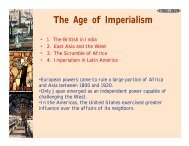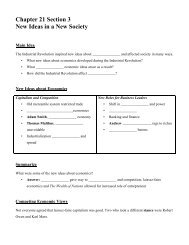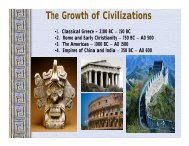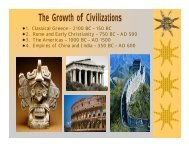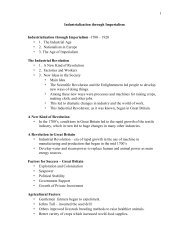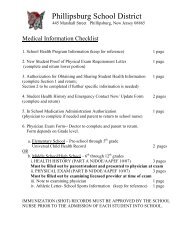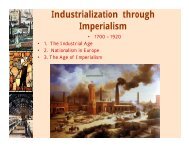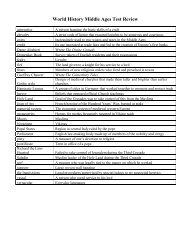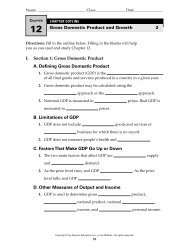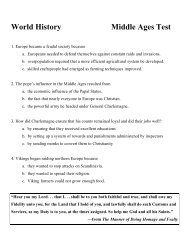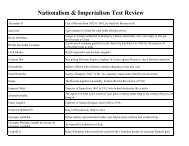19.1 PowerPoint
19.1 PowerPoint
19.1 PowerPoint
You also want an ePaper? Increase the reach of your titles
YUMPU automatically turns print PDFs into web optimized ePapers that Google loves.
Section 1<br />
Chapter 25 Section 1<br />
Chapter 19<br />
Section 1<br />
From<br />
Neutrality to<br />
War<br />
The Cold From War Begins Neutrality to War
Section 1<br />
Chapter 25 Section 1<br />
Focus<br />
What caused World War I, and why<br />
did the United States enter the war?<br />
In 1914, nationalism, militarism,<br />
imperialism, and entangling alliances<br />
combined to drag Europe into a world war.<br />
The United States attempted to remain<br />
neutral but abandoned its long tradition of<br />
staying out of European conflicts.<br />
The Cold From War Begins Neutrality to War
Section 1<br />
Chapter 25 Section 1<br />
Causes of War<br />
In 1914, five factors made Europe a powder<br />
keg ready to explode.<br />
Nationalism<br />
Militarism<br />
Economic rivalries<br />
Imperial ambitions<br />
Regional tensions<br />
The Cold From War Begins Neutrality to War
Section 1<br />
Chapter 25 Section 1<br />
Nationalism<br />
Nationalism, or devotion to one’s country, caused<br />
tensions to rise.<br />
• Among the powers of Europe, nationalism<br />
caused a desire to avenge perceived insults<br />
and past losses.<br />
• Some felt national identity centered around a<br />
single ethnic group and questioned the loyalty<br />
of ethnic minorities.<br />
• Social Darwinists applied the idea of “survival<br />
of the fittest” to nations.<br />
The Cold From War Begins Neutrality to War
Section 1<br />
Chapter 25 Section 1<br />
Economic Competition<br />
Economic competition for trade and<br />
colonies increased nationalistic feelings.<br />
Economic competition caused a demand for<br />
colonies and military bases in Africa, the Pacific<br />
islands, and China.<br />
Alliances provided a promise of assistance<br />
that made some leaders reckless or overly<br />
aggressive.<br />
The Cold From War Begins Neutrality to War
Section 1<br />
Chapter 25 Section 1<br />
Arms Race<br />
Nations stockpiled new technology, including machine<br />
guns, mobile artillery, tanks, submarines, and airplanes.<br />
Militarism,<br />
combined<br />
with<br />
nationalism,<br />
led to<br />
an arms race.<br />
The Cold From War Begins Neutrality to War
Section 1<br />
Chapter 25 Section 1<br />
Assassination<br />
On June 28, 1914,<br />
Serb nationalists<br />
assassinated the<br />
heir to the throne of<br />
Austria-Hungary,<br />
Archduke, Francis<br />
Ferdinand.<br />
The assassination triggered<br />
a chain of events that drew<br />
two sets of allies into a<br />
bloody conflict.<br />
The Cold From War Begins Neutrality to War
Section 1<br />
Chapter 25 Section 1<br />
Assassination<br />
The Cold From War Begins Neutrality to War
Section 1<br />
Chapter 25 Section 1<br />
Alliances<br />
Europe’s alliance system caused the conflict to spread<br />
quickly, creating two main combatants.<br />
Allied Powers<br />
included<br />
Britain, France,<br />
Russia,<br />
and Serbia.<br />
Central Powers<br />
included<br />
Germany<br />
and Austria-<br />
Hungary.<br />
The Cold From War Begins Neutrality to War
Section 1<br />
Chapter 25 Section 1<br />
The War Begins<br />
Germany invaded<br />
Belgium, a neutral<br />
country, to attack France.<br />
The German advance was<br />
stopped about 30 miles<br />
from Paris.<br />
The war bogged down as<br />
both sides dug a long<br />
series of trenches, creating<br />
the Western Front.<br />
The Cold From War Begins Neutrality to War
Section 1<br />
Chapter 25 Section 1<br />
New Weapons<br />
The era’s deadly defensive weapons made attacks<br />
difficult and dangerous.<br />
Neither side could<br />
overcome the<br />
other’s defenses,<br />
and a stalemate<br />
quickly developed.<br />
The Cold From War Begins Neutrality to War
Section 1<br />
Chapter 25 Section 1<br />
Isolationism<br />
As the war<br />
dragged on in<br />
Europe, President<br />
Wilson urged<br />
Americans to<br />
remain neutral.<br />
• The United States had a long<br />
tradition of staying out of<br />
European conflicts.<br />
• Yet one-third of Americans<br />
had been born in a foreign<br />
country and still identified<br />
with their homelands.<br />
Many Americans favored one<br />
side or the other.<br />
The Cold From War Begins Neutrality to War
Section 1<br />
Chapter 25 Section 1<br />
Americans are Divided<br />
U.S. public opinion fell into three main groups.<br />
Isolationists<br />
Interventionists<br />
Internationalists<br />
Favored staying out of the<br />
war<br />
Favored fighting on the<br />
Allies’ side<br />
Wanted the U.S. to play a<br />
role for peace but not fight<br />
The Cold From War Begins Neutrality to War
Section 1<br />
Chapter 25 Section 1<br />
Blockade<br />
Early in the war,<br />
the British navy<br />
had set up a<br />
blockade of<br />
Germany.<br />
• Britain’s goal was to intercept<br />
contraband goods.<br />
• In defiance of international<br />
law, Britain also prevented<br />
non-contraband goods, such<br />
as food and gasoline, from<br />
reaching Germany.<br />
Germany responded by<br />
trying to blockade Britain.<br />
The Cold From War Begins Neutrality to War
Section 1<br />
Chapter 25 Section 1<br />
The Lusitania<br />
German U-boats<br />
torpedoed ships<br />
bound for<br />
Britain.<br />
On May 7, 1915,<br />
a U-boat sank the<br />
British passenger<br />
ship Lusitania off<br />
the coast of Ireland,<br />
killing many<br />
Americans.<br />
The Cold From War Begins Neutrality to War
Section 1<br />
Chapter 25 Section 1<br />
America Prepares for War<br />
Americans were angry about the Lusitania. Germany failed to<br />
keep its promise to not sink any more passenger ships.<br />
• President Wilson still<br />
wanted peace, but he<br />
began to prepare for<br />
the possibility of war.<br />
• In 1916, Congress<br />
expanded the army and<br />
authorized more<br />
warships.<br />
The Cold From War Begins Neutrality to War
Section 1<br />
Chapter 25 Section 1<br />
Wilson Ask for War<br />
Two events in 1917 led President Wilson<br />
to ask Congress to declare war on<br />
the Central Powers.<br />
• The Zimmermann Note was intercepted. In<br />
this telegram, Germany tried to forge an<br />
alliance with Mexico against the United States.<br />
• Germany returned to a policy of unrestricted<br />
submarine warfare, sinking any ship headed for<br />
Britain.<br />
The Cold From War Begins Neutrality to War
Section 1<br />
Chapter 25 Section 1<br />
Congress Declares War<br />
On April 2, 1917, Wilson<br />
asked Congress to<br />
declare war against<br />
Germany, saying<br />
“The world must<br />
be made safe for<br />
democracy.”<br />
Congress responded with a declaration<br />
of war on April 6, and the<br />
United States entered World War I.<br />
The Cold From War Begins Neutrality to War



